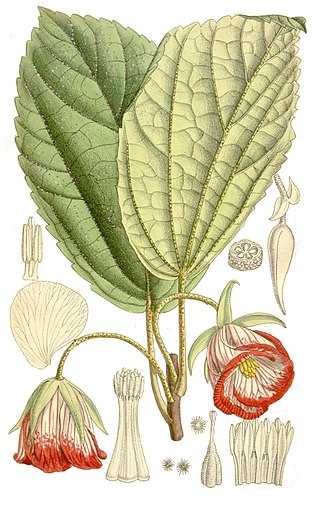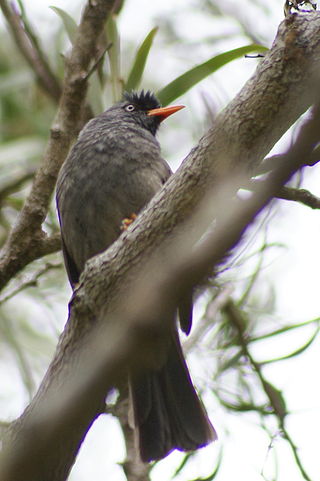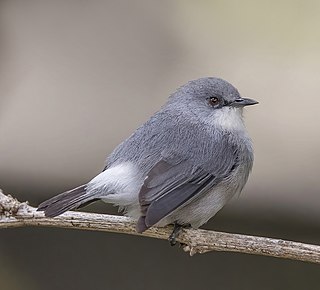
Zosterops is a genus of passerine birds containing the typical white-eyes in the white-eye family Zosteropidae. The genus has the largest number of species in the white-eye family. They occur in the Afrotropical, Indomalayan, and Australasian realms. Typical white-eyes have a length of between 8 and 15 cm. Their most characteristic feature is a conspicuous white feather ring around the eye, though some species lack it. The species in this group vary in the structural adaptations of the tongue. The Zosterops [griseotinctus] group is an example of a "great speciator" inhabiting a vast area and showing a remarkable morphological differentiation on islands, some of which may be as close as 2 km (1.2 mi) apart.

Angraecum, also known as comet orchid, is a genus of the family Orchidaceae native to tropical and South Africa, as well as Sri Lanka. It contains 223 species.

The Mascarene Islands or Mascarenes or Mascarenhas Archipelago is a group of islands in the Indian Ocean east of Madagascar consisting of islands belonging to the Republic of Mauritius as well as the French department of La Réunion. Their name derives from the Portuguese navigator Pedro Mascarenhas, who first visited them in April 1512. The islands share a common geological origin beneath the Mascarene Plateau known as the Mauritia microcontinent which was a Precambrian microcontinent situated between India and Madagascar until their separation about 70 million years ago. They form a distinct ecoregion with unique biodiversity and endemism of flora and fauna.

The hoopoe starling, also known as the Réunion starling or Bourbon crested starling, is a species of starling that lived on the Mascarene island of Réunion and became extinct in the 1850s. Its closest relatives were the also-extinct Rodrigues starling and Mauritius starling from nearby islands, and the three apparently originated in south-east Asia. The bird was first mentioned during the 17th century and was long thought to be related to the hoopoe, from which its name is derived. Some affinities have been proposed, but it was confirmed as a starling in a DNA study.

Trochetia is a subgenus of flowering plants, now placed in the genus Ruizia and the family Malvaceae. Species are endemic to the Mascarene Islands. The original genus was first described by A.P. de Candolle in 1823, who named it in honour of French botanist Henri Dutrochet.

The Mauritius bulbul, is a songbird belonging to the bulbul family, Pycnonotidae. It is endemic to Mauritius.

The Réunion bulbul is a species of the bulbul family of passerine birds. It is endemic to Réunion.

The Marianne white-eye, also known as Seychelles chestnut-sided white-eye or Seychelles yellow white-eye, is an extinct species of small bird in the white-eye family.

The Mascarene martin or Mascarene swallow is a passerine bird in the swallow family that breeds in Madagascar and in the Mascarene Islands. The nominate subspecies occurs on Mauritius and Réunion and has never been found away from the Mascarene Islands, but the smaller Madagascan subspecies, P. b. madagascariensis, is migratory and has been recorded wintering in East Africa or wandering to other Indian Ocean islands.

The Mascarene paradise flycatcher is a species of bird in the monarch-flycatcher family Monarchidae. It is endemic to the Mascarene islands of Mauritius and Réunion. There are two subspecies recognized: the nominate subspecies from Réunion, also known as the Réunion paradise flycatcher; and T. b. desolata from Mauritius. The Mascarene paradise flycatcher was originally described in the genus Muscicapa and the subspecies T. b. desolata was originally described as a separate species.
Sanford's white-eye is a species of bird in the family Zosteropidae. It is endemic to Nendo Island. It is named after Leonard Cutler Sanford, a trustee of the American Museum of Natural History.

The Makira white-eye, also known as the grey-throated white-eye, is a small passerine bird in the white-eye family, Zosteropidae. It is also known as Zosterops ugiensis because Z. rendovae has often been used for the Solomons white-eye.

The Mauritius grey white-eye is a species of bird in the family Zosteropidae. It is one of two white-eye species endemic to the island of Mauritius, the other being the rare and localized Mauritius olive white-eye. It inhabits woodlands, forests, and gardens. The Réunion grey white-eye is very closely related. They were formerly considered conspecific and together called Mascarene white-eye.
Grey white-eye may refer to:
The Mascarene white-eye has been split into the following species:

The sangkar white-eye is a bird species in the family Zosteropidae. It is also known as the Sunda white-eye. It is found in forested habitats on the Indonesian islands of Java and Bali. In Java it is typically found at elevations between 200–1,600 m (660–5,250 ft), but it sometimes occurs at lower elevations as well.
The Kafa white-eye is a small passerine bird in the white-eye family, Zosteropidae. It is found in west and southwest Ethiopia as well as on Mount Kulal in north Kenya. It was formerly considered to be a subspecies of Ethiopian white-eye.


















